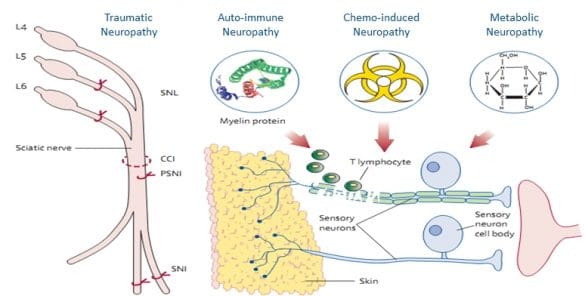ANS Biotech has established robust and relevant in vivo models for neuropathic pain in order to help you to select and validate your compounds in this challenging field.
The model of Chronic Constriction Injury (CCI) is based on a discrete peripheral nerve injury and can be related to post-traumatic / postsurgical neuropathic pain experienced by patients. Unilateral peripheral mononeuropathy is induced by loose ligation of the sciatic nerve of the hindpaw of the rat. Fourteen days later, mechanical hyperalgesia, mechanical allodynia, tactile allodynia and thermal allodynia are measured to reveal the analgesic potency of your drugs.
The model of Spinal Nerve Ligation (SNL) is based on a discrete peripheral nerve injury and can be related to post-traumatic / postsurgical neuropathic pain experienced by patients. In the SNL model, a unilateral peripheral mononeuropathy is induced by tight ligation of the 5th and 6th spinal nerves of the lumbar dorsal roots (L5 & L6) of the hindpaw of the rat. Fourteen days later, mechanical allodynia is assessed using the electronic Von Frey test to reveal the analgesic potency of your drugs.
The model of Spared Nerve Injury (SNI) is a model of peripheral mononeuropathy based on the nerve injury of the tibial and the common peroneal nerves, sparing the sural nerve. This model can be related to post-traumatic / postsurgical neuropathic pain experienced by patients. Fourteen days after ligation and section of these nerves, mechanical hyperalgesia, mechanical allodynia and tactile allodynia are measured to reveal the analgesic potency of your drugs.
In humans, diabetic neuropathy stands as one of the primary causes of neuropathic pain. Among the various animal models utilized to investigate this condition, the streptozotocin model is the most widely used due to its utility in investigating pain mechanisms. In this experimental model, neuropathy is produced in rats using a single intraperitoneal injection of streptozotocin to induce diabetes and, in turn, hyperalgesia and allodynia. Seven days later (D7), diabetic animals present with a significant increase in glycemia along with weight loss, polydipsia and polyuria. Fourteen days later (D21), animals exhibit both mechanical hyperalgesia and allodynia which can be measured using mechanical stimulation.
Oxaliplatin is a third-generation platinum-based chemotherapeutic drug widely used in the treatment of advanced metastatic colorectal cancer. In patients, its use is limited by a chronic and cumulative neurotoxicity, characterized by dysesthesia and paresthesia in the distal extremities, spontaneous pain and loss of sensation. An experimental model of oxaliplatin-induced chronic peripheral sensory neuropathy is induced by repeated intraperitoneal injections of oxaliplatin (4 mg/kg) twice weekly over 3 consecutive weeks. Cold allodynia is measured using a cryothermostat with significant behavioral nociceptive signs emerging that are consistent with clinical symptoms and increase progressively in duration and severity with the repetition of treatment-cycles. This model is useful to evaluate the analgesic effects of new compounds on oxaliplatin-induced chronic painful symptoms.
Neuropathic Pain (NP) is one of the most difficult types of pain to treat in humans and is characterized by long-lasting exaggerated pain behavior such as hyperalgesia and allodynia in animals. The majority of the preclinical models are based on a discrete peripheral nerve injury and can be related to the post-traumatic / postsurgical neuropathic pain experienced by patients. In research, mechanical nerve injury can result from acute or chronic nerve ligation or more severely by the partial or complete severing of a nerve.
ANS Biotech offers several mechanical nerve injury models that have proven their usefulness in the experimental study of NP in rodents. In these various models, nerve roots can be ligated (or severed), the sciatic nerve can be partially ligated or a chronic constriction can be placed around it. Also, nerves emanating from the sciatic nerve (tibial and common peroneal nerves) can be ligated (or severed). These procedures share the common feature that the innervation of the foot remains partially intact, allowing tests for allodynia and hyperalgesia to be undertaken.
Mechanical trauma is not the only way a nerve can be injured. Injury can also occur as a result of a metabolic disorder (diabetes), chemically induced nerve trauma (CIPN), infection (postherpetic neuralgia) or autoimmune disorders.
ANS Biotech also proposes other models of NP that more closely mimic individual disease states such as painful diabetic neuropathy and chemotherapy-induced peripheral neuropathy.
Several diabetic models are available, but the most commonly used model for the study of pain is the Streptozotocin-induced diabetic NP model (STZ model). This model has been extensively used for testing compounds such as gabapentin and pregabalin.
In chemotherapy, cumulative dose-limiting toxicity is a major problem due to the painful neuropathy induced by antineoplastic agents. When preclinically administered, these chemicals also produce sensory neuropathies consistent with those reported in patients. This is the case with Oxaliplatin-induced cold allodynia.

